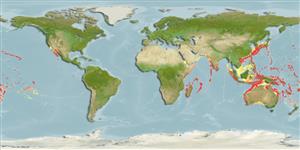>
Scombriformes (Mackerels) >
Bramidae (Pomfrets)
Etymology: Taractichthys: Greek, taraktes = confusion; for the pletora of names that have been applied to this fish + Greek, ichthys = fish (Ref. 45335).
Eponymy: Franz Steindachner (1834–1919) was an Austrian zoologist who specialised in herpetology and ichthyology. [...] (Ref. 128868), visit book page.
More on author: Döderlein.
Environment: milieu / climate zone / intervalo de profundidade / distribution range
Ecologia
marinhas bentopelágico; oceanódromo (Ref. 51243); intervalo de profundidade 50 - 700 m (Ref. 58488). Tropical; 40°N - 36°S, 40°E - 110°W
Indo-Pacific and Eastern Central Pacific: East Africa to California, USA. References to Taractichthys longipinnis in the Indo-Pacific are considered misidentifications of this species. Highly migratory species.
Tamanho / Peso / Idade
Maturidade: Lm ? range ? - ? cm
Max length : 60.0 cm TL macho/indeterminado; (Ref. 4388); peso máx. Publicado: 11.0 kg (Ref. 4388); Idade máx. registada: 8 anos (Ref. 4388)
Espinhos dorsais (total) : 0; Raios dorsais moles (total) : 33 - 37; Espinhos anais: 0; Raios anais moles: 26 - 28; Vértebras: 44 - 46. Body covered with large hard scales, each with a spine. Anterior lobes of dorsal and anal fins high, but changing in shape and height with growth; both fins covered with scales, not depressible in a groove. There are no areas without scales above nor behind the eye. Adults without a lateral line. Attains 60 cm SL.
Body shape (shape guide): short and / or deep; Cross section: compressed.
Occurs along the shelf edge (Ref. 11230).
Life cycle and mating behavior
Maturidade | Reprodução | Desova | Ovos | Fecundidade | Larvas
Smith, M.M., 1986. Bramidae. p. 633-636. In M.M. Smith and P.C. Heemstra (eds.) Smiths' sea fishes. Springer-Verlag, Berlin. (Ref. 4388)
Categoria na Lista Vermelha da IUCN (Ref. 130435: Version 2025-1)
Ameaça para o homem
Harmless
Utilização humana
Pescarias: espécies comerciais
Ferramentas
Relatórios especiais
Descarregue XML
Fontes da internet
Estimates based on models
Preferred temperature (Ref.
123201): 10.7 - 21.6, mean 15.2 °C (based on 425 cells).
Phylogenetic diversity index (Ref.
82804): PD
50 = 0.7500 [Uniqueness, from 0.5 = low to 2.0 = high].
Bayesian length-weight: a=0.01995 (0.00906 - 0.04395), b=3.01 (2.83 - 3.19), in cm total length, based on all LWR estimates for this body shape (Ref.
93245).
Nível Trófico (Ref.
69278): 4.1 ±0.6 se; based on size and trophs of closest relatives
Resiliência (Ref.
120179): Médio, tempo mínimo de duplicação da população 1,4 - 4,4 anos (tmax=8).
Fishing Vulnerability (Ref.
59153): Moderate vulnerability (44 of 100).
🛈
Nutrients (Ref.
124155): Calcium = 54.1 [21.9, 131.3] mg/100g; Iron = 0.654 [0.306, 1.396] mg/100g; Protein = 17.8 [15.9, 19.8] %; Omega3 = 0.215 [0.109, 0.403] g/100g; Selenium = 98.8 [41.5, 229.7] μg/100g; VitaminA = 33.1 [9.1, 142.0] μg/100g; Zinc = 0.735 [0.447, 1.151] mg/100g (wet weight);
